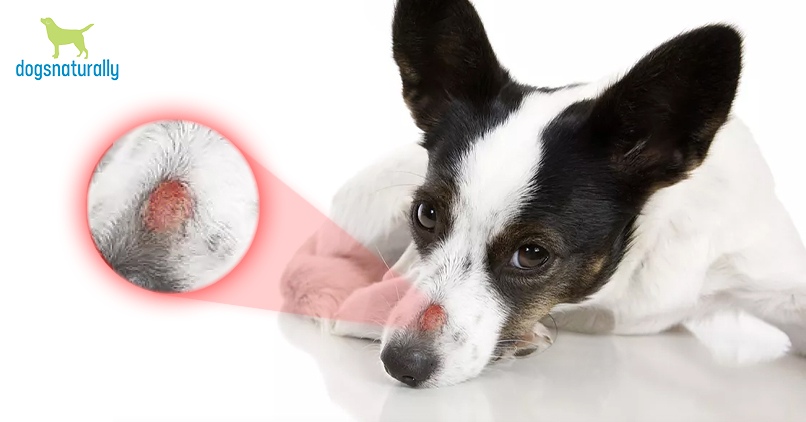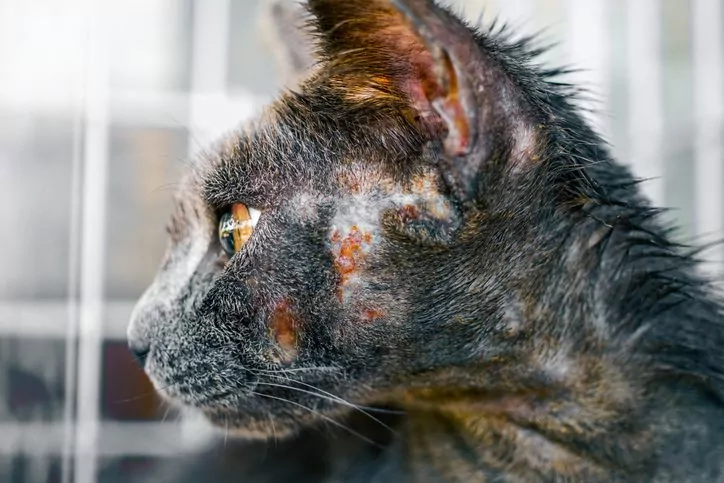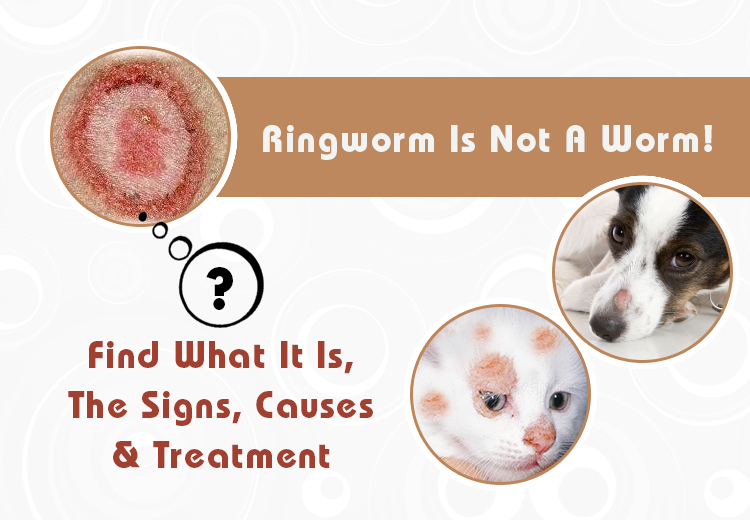To determine if your dog has ringworm, look for areas of hair loss with a crusty or scaly covering, as well as red lesions or patches of broken hair. Ringworm may have different appearances in dogs, but these are the common signs to watch for.
Treatment options include topical creams and ointments containing miconazole, terbinafine, or clotrimazole. It’s important to consult with a veterinarian for an accurate diagnosis and appropriate treatment.

Credit: www.dogsnaturallymagazine.com
Understanding Ringworm In Dogs
Detecting ringworm in dogs can be identified through symptoms such as hair loss, crusty skin, or red lesions. Pay close attention to your dog’s paws, legs, head, or ears as these areas are more prone to ringworm infection. Seek veterinary treatment for proper diagnosis and treatment.
What Is Ringworm?
Ringworm is a common fungal infection that can affect dogs. Despite its name, it is not caused by worms but by a group of fungi called dermatophytes. These fungi thrive in warm and humid environments, making dogs more susceptible to infection, especially if they have compromised immune systems or live in crowded or unsanitary conditions.Symptoms Of Ringworm In Dogs
Recognizing the symptoms of ringworm in dogs is crucial for timely treatment. While the appearance of ringworm can vary, it often manifests as areas of hair loss with a crusty covering. In some cases, affected areas may look like grey, scaly patches, while in others, they may appear as red lesions. You may also notice patches of broken hair or general hair loss. It’s important to note that dogs with ringworm may not show any symptoms at all, making it challenging for pet owners to detect the infection without proper examination.Diagnosing Ringworm In Dogs
If you suspect that your dog may have ringworm, it is essential to get a proper diagnosis from a veterinarian. Diagnosing ringworm typically involves a combination of tests, including a Wood’s lamp examination, fungal culture, and microscopic examination of skin samples. By conducting these tests, the veterinarian can confirm the presence of dermatophytes and determine the best course of treatment for your furry friend.When it comes to treating ringworm in dogs, there are various options available. Topical treatments, such as creams and ointments containing antifungal medications like miconazole or terbinafine, are commonly used for localized infections. In more severe cases, oral medications or medicated shampoos may be prescribed. It’s important to follow the veterinarian’s instructions closely to ensure effective treatment and prevent the spread of infection to other pets or family members. In addition to medication, maintaining good hygiene practices is crucial in managing ringworm in dogs. Regularly cleaning your dog’s living areas, bedding, and grooming tools can help prevent the spread of the fungus. It’s also advisable to isolate infected dogs from other pets until they are fully treated and cleared by the veterinarian.By understanding the nature of ringworm in dogs and being aware of its symptoms and diagnostic methods, pet owners can take the necessary steps to protect their furry companions and ensure their well-being. If you suspect that your dog may have ringworm, it’s best to consult with a veterinarian for a proper diagnosis and guidance on the most appropriate treatment options.
Credit: nativepet.com
Treating And Managing Ringworm In Dogs
Ringworm is a common skin infection in dogs that can cause discomfort and irritation. If left untreated, it can also spread to other animals and even to humans. Treating and managing ringworm in dogs is essential for their health and wellbeing.
Topical Treatment
One of the most common methods of treating ringworm in dogs is through topical treatment. Various creams and ointments containing miconazole (Micaved®), terbinafine (Lamisil®), or clotrimazole (Otomax® or Otibiotic®) can be applied to localized areas of the skin affected by ringworm. These medications help to eliminate the fungal infection and promote healing. It’s important to follow the instructions provided by your veterinarian and apply the medication regularly for the recommended duration.
Other Potential Skin Conditions
While ringworm is a common skin condition in dogs, there are other skin conditions that may have similar symptoms. Bacterial skin infections (pyoderma), skin yeast infections, and allergies are some examples of skin conditions that may be mistaken for ringworm. It’s important to consult with a veterinarian for an accurate diagnosis. They can perform tests, such as a fungal culture or microscopic examination, to determine if ringworm is the underlying cause of your dog’s symptoms.
Preventing Ringworm Infection
Preventing ringworm infection is crucial for your dog’s overall health and to minimize the risk of transmission to humans and other animals. Here are some tips to help prevent ringworm in dogs:
- Keep your dog’s living area clean and well-maintained, regularly cleaning and disinfecting surfaces and bedding.
- Minimize contact with unfamiliar animals, especially those with visible skin issues.
- Ensure your dog receives regular grooming, including bathing and brushing, to maintain a healthy coat and skin.
- Avoid sharing grooming tools or equipment between animals, as this can facilitate the spread of ringworm.
- Keep your dog’s immune system strong with a balanced diet, regular exercise, and regular veterinary check-ups.
By implementing these preventive measures and seeking prompt treatment for ringworm, you can help your dog recover from the infection and ensure a healthy and happy life for them.
Ringworm And Its Impact On Humans
If you suspect that your dog has ringworm, look for signs such as areas of hair loss with a crusty covering or red lesions. Some dogs may also experience patches of broken hair. Treatments such as creams and ointments containing miconazole, terbinafine, or clotrimazole can be applied to localized areas of the infected skin.
Can Humans Get Ringworm From Dogs?
Yes, humans can contract ringworm from dogs. Ringworm is a highly contagious fungal infection that can be transmitted from animals to humans through direct contact or by touching contaminated items such as bedding, grooming tools, or furniture. The fungal spores responsible for causing ringworm can survive for extended periods in the environment, making it crucial to take preventive measures to avoid the spread of infection.
Risk Factors For Humans
While anyone can get ringworm, certain individuals are at a higher risk. People who have close contact with infected animals, such as dogs, cats, puppies, kittens, and pet rats, are more susceptible to contracting ringworm. Additionally, children, seniors, and individuals with weakened immune systems have a higher likelihood of becoming infected.
Preventing Human Infection
To prevent the transmission of ringworm from dogs to humans, it is essential to take the following precautions:
- Practice good hygiene: Wash your hands thoroughly after handling your dog, especially if you notice any signs of ringworm.
- Avoid close contact: Minimize direct contact with an infected dog’s skin, hair, or lesions.
- Keep your dog clean: Regularly bathe and groom your dog to prevent the buildup of fungal spores on their skin and hair.
- Isolate infected dogs: If you suspect your dog has ringworm, isolate them from other animals and humans until they have received appropriate treatment.
- Disinfect your home: Clean and disinfect surfaces, bedding, and grooming tools regularly to eliminate any fungal spores that may be present.
- Seek veterinary care: If you suspect your dog has ringworm, consult a veterinarian for proper diagnosis and treatment.
By following these preventive measures, you can significantly reduce the risk of human infection and ensure the well-being of both your dog and your family.

Credit: careyanimalhospital.com
Frequently Asked Questions On How Do I Know If My Dog Has Ringworm
What Are The First Signs Of Ringworm In A Dog?
The first signs of ringworm in a dog may include areas of hair loss with a crusty covering or red lesions. Patches of ringworm can appear as grey, scaly patches or broken hair. It may also be asymptomatic in some dogs.
If you notice these symptoms, consult a veterinarian for diagnosis and treatment.
How Do You Get Rid Of Ringworm In A Dog?
To get rid of ringworm in a dog, use topical treatments like creams and ointments containing miconazole, terbinafine, or clotrimazole. These can be applied to the affected areas of the skin. Make sure to consult a veterinarian for proper diagnosis and treatment.
What Could Be Mistaken For Ringworm In Dogs?
Bacterial skin infection, skin yeast infections, and allergies may look similar to ringworm in dogs. Seek professional diagnosis for proper treatment.
Can Humans Get Ringworm From Dogs?
Yes, humans can get ringworm from dogs. Close contact with infected animals, especially puppies or kittens, increases the risk. People with weakened immune systems are also more susceptible.
Conclusion
To determine if your dog has ringworm, be on the lookout for signs of hair loss with a crusty covering or red lesions. These patches may appear grey and scaly in some dogs. Remember, ringworm can affect any part of your dog’s body, so be thorough in your examination.
If you suspect ringworm, consult with your veterinarian for proper diagnosis and treatment options. Don’t worry, with the right treatment, your furry friend can overcome this fungal infection.



